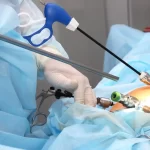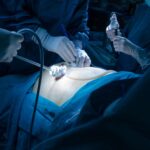Demystifying Laparoscopic Hernia Surgery: Common Myths vs. Facts
Introduction:
Laparoscopic hernia surgery, also referred to as minimally invasive hernia repair, has gained favour among patients for its advantages over traditional open surgery. Despite its increasing popularity, misconceptions persist. This article aims to debunk common myths associated with laparoscopic hernia surgery. Firstly, it’s believed that this procedure is riskier than open surgery, whereas studies show comparable safety profiles. Secondly, some assume it’s less effective, yet research demonstrates similar or even superior outcomes in terms of recurrence rates and recovery time. Lastly, concerns about cost often arise, though evidence suggests that long-term savings may be achieved due to reduced hospital stays and faster return to work. By addressing these myths with factual information, patients can make informed decisions about their hernia treatment.
Explanation of Laparoscopic Hernia Surgery:
Before dispelling misconceptions, it’s crucial to grasp the essence of laparoscopic hernia surgery. Unlike conventional open surgery that necessitates a large incision to reach the hernia, laparoscopic surgery employs small incisions. Through these, a miniature camera (laparoscope) and specialised surgical tools are introduced. This technique enables surgeons to mend the hernia with enhanced accuracy while minimising tissue trauma. By utilising laparoscopic methods, medical professionals can achieve a more precise and less invasive approach, promoting faster recovery and reduced postoperative discomfort for patients. This advanced surgical approach represents a significant advancement in hernia treatment, offering patients a more efficient and less intrusive alternative to traditional open surgery.
Section 1: Myths about Laparoscopic Hernia Surgery
Before dispelling misconceptions, it’s crucial to grasp the essence of laparoscopic hernia surgery. Unlike conventional open surgery that necessitates a large incision to reach the hernia, laparoscopic surgery employs small incisions. Through these, a miniature camera (laparoscope) and specialised surgical tools are introduced. This technique enables surgeons to mend the hernia with enhanced accuracy while minimising tissue trauma. By utilising laparoscopic methods, medical professionals can achieve a more precise and less invasive approach, promoting faster recovery and reduced postoperative discomfort for patients. This advanced surgical approach represents a significant advancement in hernia treatment, offering patients a more efficient and less intrusive alternative to traditional open surgery.
Section 2: Benefits of Laparoscopic Approach
Laparoscopic hernia repair offers significant advantages over traditional open surgery, particularly in terms of scarring and recovery. With laparoscopic techniques, surgeons make only small incisions, minimising visible scarring and reducing the likelihood of long-term cosmetic concerns. Moreover, these smaller incisions result in less trauma to surrounding tissues compared to open surgery, facilitating a quicker recovery process. By minimising tissue disruption, patients experience less postoperative pain and discomfort, enabling them to resume normal activities sooner. This approach not only enhances cosmetic outcomes but also promotes better overall patient satisfaction and quality of life. With less scarring and faster recovery times, laparoscopic hernia repair represents a more appealing option for patients seeking effective and minimally invasive treatment for their hernias.
Section 3: Common Myths Debunked
Contrary to popular belief, there’s a prevailing myth that laparoscopic hernia surgery poses a greater risk of complications compared to traditional open surgery. However, extensive research indicates otherwise. Multiple studies have consistently demonstrated that the rates of complications associated with laparoscopic hernia repair are either comparable to or even lower than those linked to open surgery. This finding challenges the misconception and underscores the safety and efficacy of laparoscopic techniques in hernia repair. Factors such as reduced tissue trauma, smaller incisions, and enhanced visualisation contribute to the favourable outcomes observed in laparoscopic procedures. Consequently, patients should be reassured that opting for laparoscopic hernia surgery does not inherently elevate their risk of experiencing postoperative complications, offering them a viable and potentially advantageous alternative to conventional open surgery.
Despite misconceptions, laparoscopic hernia repair isn’t less effective than open surgery. This myth likely stems from outdated beliefs or limited understanding. Numerous studies have consistently shown comparable outcomes between laparoscopic and open surgeries regarding recurrence rates and long-term effectiveness. Laparoscopic techniques offer several advantages, including smaller incisions, reduced postoperative pain, faster recovery times, and lower rates of complications such as infection. Additionally, laparoscopic procedures enable surgeons to access hard-to-reach areas more easily and with greater precision. Patients undergoing laparoscopic hernia repair often experience shorter hospital stays and quicker return to normal activities compared to those undergoing open surgery. Therefore, debunking the misconception that laparoscopic repair is less effective is crucial for promoting informed decision-making and ensuring patients receive optimal care for their hernias.
Section 4: Procedure Overview
During laparoscopic hernia surgery, the surgeon starts by making small incisions in the abdominal wall. Through one of these incisions, a laparoscope—a tube-like instrument with a camera—is inserted to visualise the hernia. With a clear view, specialised instruments are used to repair the hernia. This involves placing a mesh over the weakened area to reinforce it, preventing recurrence. The mesh is securely fixed in place using sutures or surgical staples. Once the repair is deemed successful, the incisions are closed either with dissolvable sutures or surgical glue. Compared to traditional open surgery, laparoscopic hernia repair typically results in less pain, faster recovery, and smaller scars, making it a preferred option for many patients.
Section 5: Patient Testimonials
Real-life experiences offer invaluable perspectives on laparoscopic hernia surgery. Patients commonly describe minimal discomfort during recovery, highlighting the procedure’s safety and efficacy. Many find themselves pleasantly surprised by the quick return to normal activities, surpassing initial expectations. Hearing firsthand accounts from individuals who have undergone this surgery can alleviate fears and uncertainties, providing reassurance to those considering it. These testimonials often emphasise the benefits of laparoscopic techniques, such as reduced postoperative pain and shorter recovery times compared to traditional open surgery. Such accounts not only offer insight into the physical aspects of recovery but also the emotional journey, fostering a sense of empowerment and confidence in the decision to undergo the procedure. Overall, real-life experiences serve as valuable resources, offering practical insights and encouragement to individuals navigating the prospect of hernia surgery.
Conclusion:
In conclusion, the advantages of laparoscopic hernia surgery are evident, surpassing those of traditional open surgery. With reduced postoperative discomfort, swiffer recuperation, and minimal scarring, it stands as a superior option. Through dispelling prevalent misconceptions and furnishing accurate insights into the procedure, our aim is to assuage any apprehensions among prospective patients. It’s imperative to underscore the safety and efficacy of laparoscopic hernia repair, emphasising its track record of success. Therefore, if you or a loved one contemplates hernia surgery, it’s advisable to seek counsel from a proficient surgeon. Collaborate with them to discern the optimal approach tailored to your specific requirements. Your well-being is paramount, and informed decision-making is pivotal in ensuring a smooth surgical journey towards recovery.

 Previous Post
Previous Post Next Post
Next Post